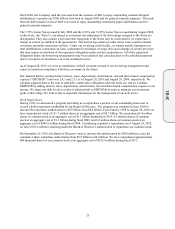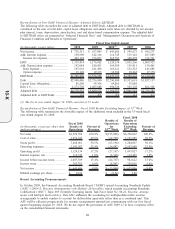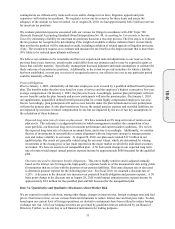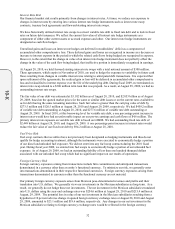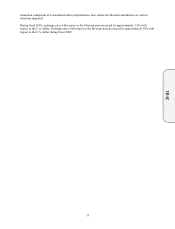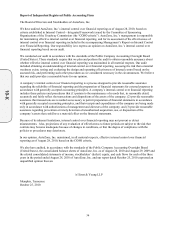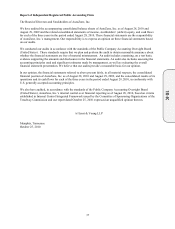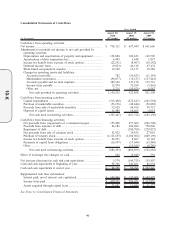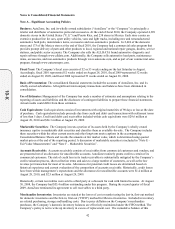AutoZone 2010 Annual Report Download - page 122
Download and view the complete annual report
Please find page 122 of the 2010 AutoZone annual report below. You can navigate through the pages in the report by either clicking on the pages listed below, or by using the keyword search tool below to find specific information within the annual report.
Interest Rate Risk
Our financial market risk results primarily from changes in interest rates. At times, we reduce our exposure to
changes in interest rates by entering into various interest rate hedge instruments such as interest rate swap
contracts, treasury lock agreements and forward-starting interest rate swaps.
We have historically utilized interest rate swaps to convert variable rate debt to fixed rate debt and to lock in fixed
rates on future debt issuances. We reflect the current fair value of all interest rate hedge instruments as a
component of either other current assets or accrued expenses and other. Our interest rate hedge instruments are
designated as cash flow hedges.
Unrealized gains and losses on interest rate hedges are deferred in stockholders’ deficit as a component of
accumulated other comprehensive loss. These deferred gains and losses are recognized in income as a decrease or
increase to interest expense in the period in which the related cash flows being hedged are recognized in expense.
However, to the extent that the change in value of an interest rate hedge instrument does not perfectly offset the
change in the value of the cash flow being hedged, that ineffective portion is immediately recognized in earnings.
At August 28, 2010, we held forward starting interest rate swaps with a total notional amount of $300 million.
These agreements, which expire in November of 2010, are used to hedge the exposure to variability in future cash
flows resulting from changes in variable interest rates relating to anticipated debt transactions. It is expected that
upon settlement of the agreements, the realized gain or loss will be deferred in accumulated other comprehensive
loss and reclassified to interest expense over the life of the underlying debt. During fiscal 2009, we terminated an
interest rate swap related to a $300 million term loan that was prepaid. As a result, at August 29, 2009, we had no
outstanding interest rate swaps.
The fair value of our debt was estimated at $3.182 billion as of August 28, 2010, and $2.853 billion as of August
29, 2009, based on the quoted market prices for the same or similar debt issues or on the current rates available to
us for debt having the same remaining maturities. Such fair value is greater than the carrying value of debt by
$273.5 million and $126.5 million at August 28, 2010 and August 29, 2009, respectively. We had $459.2 million
of variable rate debt outstanding at August 28, 2010, and $277.6 million of variable rate debt outstanding at
August 29, 2009. In fiscal 2010, at this borrowing level for variable rate debt, a one percentage point increase in
interest rates would have had an unfavorable impact on our pre-tax earnings and cash flows of $4.6 million. The
primary interest rate exposure on variable rate debt is based on LIBOR. We had outstanding fixed rate debt of
$2.449 billion at August 28, 2010, and August 29, 2009. A one percentage point increase in interest rates would
reduce the fair value of our fixed rate debt by $94.2 million at August 28, 2010.
Fuel Price Risk
Fuel swap contracts that we utilize have not previously been designated as hedging instruments and thus do not
qualify for hedge accounting treatment, although the instruments were executed to economically hedge a portion
of our diesel and unleaded fuel exposure. We did not enter into any fuel swap contracts during the 2010 fiscal
year. During fiscal year 2009, we entered into fuel swaps to economically hedge a portion of our unleaded fuel
exposure. As of August 29, 2009, we had an outstanding liability of less than one hundred thousand dollars
associated with our unleaded fuel swap which had no significant impact on our results of operations.
Foreign Currency Risk
Foreign currency exposures arising from transactions include firm commitments and anticipated transactions
denominated in a currency other than an entity’s functional currency. To minimize our risk, we generally enter
into transactions denominated in their respective functional currencies. Foreign currency exposures arising from
transactions denominated in currencies other than the functional currency are not material.
Our primary foreign currency exposure arises from Mexican peso-denominated revenues and profits and their
translation into U.S. dollars. We generally view our investments in the Mexican subsidiaries as long-term. As a
result, we generally do not hedge these net investments. The net investment in the Mexican subsidiaries translated
into U.S. dollars using the year-end exchange rates was $254.6 million at August 28, 2010 and $215.4 million at
August, 29, 2009. The potential loss in value of our net investment in the Mexican subsidiaries resulting from a
hypothetical 10 percent adverse change in quoted foreign currency exchange rates at August 28, 2010 and August
29, 2009, amounted to $23.1 million and $19.6 million, respectively. Any changes in our net investment in the
Mexican subsidiaries relating to foreign currency exchange rates would be reflected in the foreign currency
32
10-K





